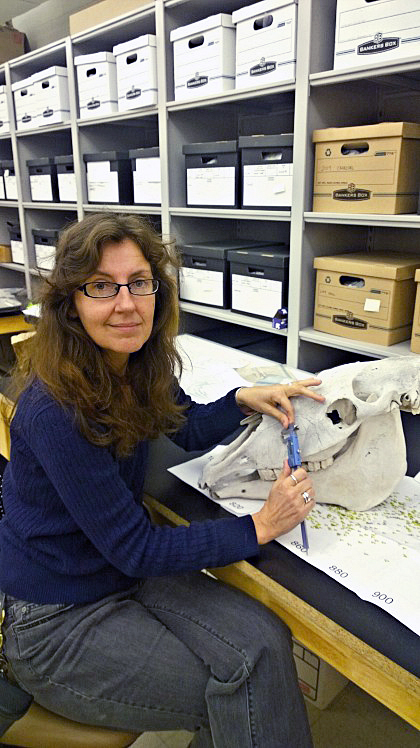

Jules Angel measuring a horse skull in an archeology lab in Smith Laboratory. Credit: Carlee Frank | Lantern Reporter
Whether you are 15 years old or 52, crime drama can be appealing. It puts some people on the edge of their seat, asking “Who did it?” However, crime scene investigations are not limited just to the worlds of “CSI” and “Law and Order,” as Ohio State has its very own team investigating working with crime scene investigations.
The Forensic Anthropology Case Team was founded in 2004 by Sam Stout, an anthropologist and professor at OSU. FACT partners with law enforcement to investigate and solve murders in Ohio, its most recent case being the ongoing Innis Park murders.
FACT is comprised of OSU faculty, as well as undergraduate, graduate and doctorate students whose primary area of study is anthropology. Alexis Dzubak, a doctorate student and team leader of FACT, explained that while building a relationship with law enforcement is not a static process, it has been very close with the city of Columbus and specifically its cold case unit for quite some time.
“That’s the nature of the game — it’s the law enforcement seeking us out as opposed to us seeking them out,” Dzubak said.
Case work usually begins with a phone call from a police department in which FACT is informed about the remains and what the police would like investigated — although this may vary case to case.
Jules Angel, a lecturer in the department of anthropology and co-director of FACT, said since 2004, the group has worked on roughly 45 cases, ranging from buried human remains to mass disasters like plane crashes.
“Some years we might have 12 cases, and other years we might have two,” Angel said. “But sometimes we can solve a case by looking at a photograph; the question being, ‘Is this human?’ and I may easily say yes or no.”
Dzubak said that her work in the classroom and with the forensics team is strenuous, but it is also worthwhile.
“On the academic side of things it’s really good to learn how this all fits together and to translate your laboratory skills into real world experience,” Dzubak said.
Angel and Dzubak both said they agree that their motives are not purely academic. Instead, the work is pro bono and not part of their teaching requirements, meaning they set time aside for FACT of their own free will.
“It’s about using our forensic expertise and giving back to the community,” Angel said.
Dzubak explained that she finds it rewarding that each case gives closure to families who might not have received it otherwise.
“I think that from a human side of things, that emotional perspective is very important to recognize as well,” she said.
Dzubak and Angel said that they hope FACT will continue building relationships with law enforcement in Ohio and supplying students with valuable field experience. Most importantly, however, they both said they hope FACT will break down stereotypes about forensic work.
“You want to break down the stereotype of a bunch of students who don’t know what they are doing and an academic who’s wandering around in some sort of foggy malaise,” Angel said.
Angel said that FACT is a veritable dream team of experts in evidence recovery, identification and excavation. She said FACT can increase the amount of content police collect, help reach conclusions they would otherwise not have and help them better understand what happened in each case.
“The police departments are using our services so they can get better evidence and then hopefully better justice,” she said.
Angel said her goal is to prove that what is taught in college is highly valuable and applicable to real-life situations. She wants students to feel encouraged to study anthropology — specifically forensic anthropology — so that FACT can continue to grow and help the Ohio community.
The Engaged Scholars logo accompanies stories that feature and examine research and teaching partnerships formed between The Ohio State University and the community (local, state, national and global) for the mutually beneficial exchange of knowledge and resources. These stories spring from a partnership with OSU’s Office of Outreach and Engagement. The Lantern retains sole editorial control over the selection, writing and editing of these stories.


